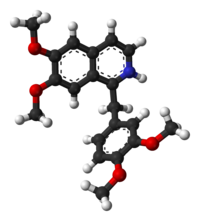- Papaverine
-
Papaverine 

Systematic (IUPAC) name 1-(3,4-dimethoxybenzyl)-6,7-dimethoxyisoquinoline Clinical data Trade names Pavabid AHFS/Drugs.com monograph MedlinePlus a682707 Pregnancy cat. USA: C[4] Legal status ? Routes Oral, intravenous, intramuscular, rectal,[5] intracavernosal Pharmacokinetic data Bioavailability 80%[3] Protein binding ~90% Metabolism Hepatic[3] Half-life 1.5–2 hours[3] Excretion Renal[3] Identifiers CAS number 58-74-2
61-25-6 (hydrochloride)ATC code A03AD01 G04BE02 PubChem CID 4680 DrugBank APRD00628 ChemSpider 4518 
UNII DAA13NKG2Q 
KEGG D07425 
ChEMBL CHEMBL19224 
Chemical data Formula C20H21NO4 Mol. mass 339.385 g/mol[1] SMILES eMolecules & PubChem  (what is this?) (verify)
(what is this?) (verify)Papaverine (
 /pəˈpævəriːn/)[1] is an opium alkaloid antispasmodic drug, used primarily in the treatment of visceral spasm, vasospasm (especially those involving the heart and the brain), and occasionally in the treatment of erectile dysfunction.[3] While it is found in the opium poppy, papaverine differs in both structure and pharmacological action from the analgesic (morphine-related) opium alkaloids (opioids).
/pəˈpævəriːn/)[1] is an opium alkaloid antispasmodic drug, used primarily in the treatment of visceral spasm, vasospasm (especially those involving the heart and the brain), and occasionally in the treatment of erectile dysfunction.[3] While it is found in the opium poppy, papaverine differs in both structure and pharmacological action from the analgesic (morphine-related) opium alkaloids (opioids).Contents
Uses
Papaverine is approved to treat spasms of the gastrointestinal tract, bile ducts and ureter and for use as a cerebral and coronary vasodilator[3] in subarachnoid hemorrhage (combined with balloon angioplasty)[6] and coronary artery bypass surgery.[7] Papaverine may also be used as a smooth muscle relaxant in microsurgery where it is applied directly to blood vessels.
Papaverine is used as an erectile dysfunction drug, alone or sometimes in combination.[2][3] Papaverine, when injected in penile tissue causes direct smooth muscle relaxation and consequent filling of the corpus cavernosum with blood resulting in erection. A topical gel is also available for ED treatment.[4]
It is also commonly used in cryopreservation of blood vessels along with the other glycosaminoglycans and protein suspensions.[5][6] Functions as a vasodilator during cryopreservation when used in conjunction with verapamil, phentolamine, nifedipine, tolazoline or nitroprusside.[7][8]
Papaverine is also being investigated as a topical growth factor in tissue expansion with some success.[9]
Papaverine is used as an off label prophylaxis (preventative) of migraine headaches.[10][11][12] It is not a first line drug such as a few beta blockers, calcium channel blockers, tricyclic antidepressants, and some anticonvulsants such as divalproex, but rather when these first line drugs and secondary drugs such as SSRIs, angiotensin II receptor antagonists, etc. fail in the prophylaxis of migraines, have intolerable side effects or are contraindicated.
Papaverine is also present in combinations of opium alkaloid salts such as papaveretum (Omnopon, Pantopon) and others, along with morphine, codeine, and in some cases noscapine and others in a percentage similar to that in opium, or modified for a given application.
Mechanism
The in vivo mechanism of action is not entirely clear, but an inhibition of the enzyme phosphodiesterase causing elevation of cyclic AMP levels is significant. It may also alter mitochondrial respiration.
Papaverine has also been demonstrated to be a selective phosphodiesterase inhibitor for the PDE10A subtype found mainly in the striatum of the brain. When administered chronically to mice, it produced motor and cognitive deficits and increased anxiety, but conversely may produce an antipsychotic effect.,[13][14] even though not all studies support this view.[15]
Side effects
Frequent side effects of papaverine treatment include polymorphic ventricular tachycardia, constipation, interference with sulphobromophthalein[8] retention test (used to determine hepatic function), increased transaminase levels, increased alkaline phosphatase levels, somnolence, and vertigo.[3]
Rare side effects include flushing of the face, hyperhidrosis (excessive sweating), cutaneous eruption, arterial hypotension, tachycardia, loss of appetite, jaundice, eosinophilia, thrombopenia, mixed hepatitis, headache, allergic reaction, chronic active hepatitis,[3] and paradoxical aggravation of cerebral vasospasm.[9]
Formulations and trade names
Papaverine is available as a conjugate of hydrochloride, codecarboxylate, adenylate, and teprosylate.[10] It was also once available as a salt of hydrobromide, camsylate, cromesilate, nicotinate, and phenylglycolate. The hydrochloride salt is available for intramuscular, intravenous, rectal and oral administration.[5] The teprosylate is available in intravenous, intramuscular, and orally administered formulations.[11] The codecarboxylate is available in oral form, only,[12] as is the adenylate.[13]
The codecarboxylate is sold under the name Albatran,[14] the adenylate as Dicertan,[15] and the hydrochloride salt is sold variously as Artegodan (Germany), Cardioverina (countries outside Europe and the United States), Dispamil (countries outside Europe and the United States), Opdensit (Germany), Panergon (Germany), Paverina Houde (Italy, Belgium), Pavacap (United States), Pavadyl (United States), Papaverine (Israel), Papaverin-Hamelin (Germany), Paveron (Germany), Spasmo-Nit (Germany),[5] Cardiospan, Papaversan, Cepaverin, Cerespan, Drapavel, Forpaven, Papalease, Pavatest, Paverolan, Therapav (France[16]), Vasospan, Cerebid, Delapav, Dilaves, Durapav, Dynovas, Optenyl, Pameion, Papacon, Pavabid, Pavacen, Pavakey, Pavased, Pavnell, Alapav, Myobid, Vasal, Pamelon, Pavadel, Pavagen, Ro-Papav, Vaso-Pav, Papanerin-hcl, Qua bid, Papital T.R., Paptial T.R., Pap-Kaps-150.[17]. In Hungary, papaverine and homatropine methylbromide are used in mild drugs that help "flush" the bile (e.g. Neo-Bilagit).
References
- ^ Papaverine - EverydayHealth.com
- ^ Desvaux, P (2005). "An overview of the management of erectile disorders". Presse medicale (Paris, France : 1983) 34 (13 Suppl): 5–7. PMID 16158020.
- ^ Bella, A. J.; Brock, G. B. (2004). "Intracavernous Pharmacotherapy for Erectile Dysfunction". Endocrine 23 (2–3): 149–155. doi:10.1385/ENDO:23:2-3:149. PMID 15146094.
- ^ Kim, E.; Elrashidy, R.; McVary, K. (1995). "Papaverine Topical Gel for Treatment of Erectile Dysfunction". The Journal of Urology 153 (2): 361. doi:10.1097/00005392-199502000-00019. PMID 7815584.
- ^ Müller-Schweinitzer E, Ellis P (May 1992). "Sucrose promotes the functional activity of blood vessels after cryopreservation in DMSO-containing fetal calf serum". Naunyn Schmiedebergs Arch. Pharmacol. 345 (5): 594–7. PMID 1528275.
- ^ Müller-Schweinitzer E, Hasse J, Swoboda L (1993). "Cryopreservation of human bronchi". J Asthma 30 (6): 451–7. doi:10.3109/02770909309056754. PMID 8244915.
- ^ Brockbank KG (February 1994). "Effects of cryopreservation upon vein function in vivo". Cryobiology 31 (1): 71–81. doi:10.1006/cryo.1994.1009. PMID 8156802. http://linkinghub.elsevier.com/retrieve/pii/S0011-2240(84)71009-1.
- ^ Giglia JS, Ollerenshaw JD, Dawson PE, Black KS, Abbott WM (November 2002). "Cryopreservation prevents arterial allograft dilation". Ann Vasc Surg 16 (6): 762–7. doi:10.1007/s10016-001-0072-1. PMID 12391500.
- ^ Tang Y, Luan J, Zhang X (2004). "Accelerating tissue expansion by application of topical papaverine cream". Plast. Reconstr. Surg. 114 (5): 1166–9. doi:10.1097/01.PRS.0000135854.48570.76. PMID 15457029.
- ^ Sillanpää, M; Koponen, M (1978). "Papaverine in the prophylaxis of migraine and other vascular headache in children". Acta paediatrica Scandinavica 67 (2): 209–12. doi:10.1111/j.1651-2227.1978.tb16304.x. PMID 343489.
- ^ Vijayan, N. (1977). "Brief therapeutic report: papaverine prophylaxis of complicated migraine". Headache 17 (4): 159–162. doi:10.1111/j.1526-4610.1977.hed1704159.x. PMID 893088.
- ^ Poser, C. M. (1974). "Letter: Papaverine in prophylactic treatment of migraine". Lancet 1 (7869): 1290. doi:10.1016/S0140-6736(74)90045-2. PMID 4134173.
- ^ Siuciak JA, Chapin DS, Harms JF, et al. (August 2006). "Inhibition of the striatum-enriched phosphodiesterase PDE10A: a novel approach to the treatment of psychosis". Neuropharmacology 51 (2): 386–96. doi:10.1016/j.neuropharm.2006.04.013. PMID 16780899. http://linkinghub.elsevier.com/retrieve/pii/S0028-3908(06)00106-7.
- ^ Hebb AL, Robertson HA, Denovan-Wright EM (May 2008). "Phosphodiesterase 10A inhibition is associated with locomotor and cognitive deficits and increased anxiety in mice". Eur Neuropsychopharmacol 18 (5): 339–63. doi:10.1016/j.euroneuro.2007.08.002. PMID 17913473. http://linkinghub.elsevier.com/retrieve/pii/S0924-977X(07)00172-1.
- ^ Weber M, Breier M, Ko D, Thangaraj N, Marzan DE, Swerdlow NR (May 2009). "Evaluating the antipsychotic profile of the preferential PDE10A inhibitor, papaverine". Psychopharmacology (Berl.) 203 (4): 723–35. doi:10.1007/s00213-008-1419-x. PMC 2748940. PMID 19066855. http://www.pubmedcentral.nih.gov/articlerender.fcgi?tool=pmcentrez&artid=2748940.
- a b c "SID 544606 — PubChem Substance Summary". http://pubchem.ncbi.nlm.nih.gov/summary/summary.cgi?sid=544606.
- a "Papaverine Material Safety Data Sheet". http://bulkpharm.mallinckrodt.com/_attachments/msds/PAPVN.htm. Retrieved 25 September 2005.
- a b c d e f g h Unknown (2000). "PAPAVERINE". Molécule(s) de base: PAPAVERINE. Biam. http://www.biam2.org/www/Sub3015.html. Retrieved 25 September 2005. (French)
- a Unknown (2004). "Who should not take papaverine?". papaverine Consumer Drug Information. Cerner Multum, Inc. http://www.drugs.com/MTM/papaverine.html. Retrieved 26 September 2005.
- a b c Unknown (1999). "PAPAVERINE CHLORHYDRATE". Molécule(s) de base: PAPAVERINE. Biam. http://www.biam2.org/www/Sub65.html. Retrieved 25 September 2005. (French)
- a Liu JK, Couldwell WT (2005). "Intra-arterial papaverine infusions for the treatment of cerebral vasospasm induced by aneurysmal subarachnoid hemorrhage". Neurocrit Care 2 (2): 124–32. doi:10.1385/NCC:2:2:124. PMID 16159054.
- a Takeuchi K, Sakamoto S, Nagayoshi Y, Nishizawa H, Matsubara J (November 2004). "Reactivity of the human internal thoracic artery to vasodilators in coronary artery bypass grafting". Eur J Cardiothorac Surg 26 (5): 956–9. doi:10.1016/j.ejcts.2004.07.047. PMID 15519189. http://linkinghub.elsevier.com/retrieve/pii/S1010-7940(04)00621-9.
- a "SID 149219 — PubChem Substance Summary". http://pubchem.ncbi.nlm.nih.gov/summary/summary.cgi?sid=149219.
- a Clyde BL, Firlik AD, Kaufmann AM, Spearman MP, Yonas H (April 1996). "Paradoxical aggravation of vasospasm with papaverine infusion following aneurysmal subarachnoid hemorrhage. Case report". J. Neurosurg. 84 (4): 690–5. doi:10.3171/jns.1996.84.4.0690. PMID 8613866. http://thejns.org/doi/abs/10.3171/jns.1996.84.4.0690?url_ver=Z39.88-2003&rfr_id=ori:rid:crossref.org&rfr_dat=cr_pub%3dncbi.nlm.nih.gov.
- a "Molécule de base: PAPAVERINE". http://www.biam2.org/www/Gsu1575.html. Retrieved 26 September 2005. Biam.
- a Unknown (1999). "PAPAVERINE TEPROSILATE". Molécule(s) de base: PAPAVERINE. Biam. http://www.biam2.org/www/Sub70.html. Retrieved 26 September 2005. (French)
- a Unknown (1998). "PAPAVERINE CODECARBOXYLATE". Molécule(s) de base: PAPAVERINE. Biam. http://www.biam2.org/www/Sub1293.html. Retrieved 26 September 2005. (French)
- a Unknown (1998). "PAPAVERINE ADENYLATE". Molécule(s) de base: PAPAVERINE. Biam. http://www.biam2.org/www/Sub1295.html. Retrieved 26 September 2005. (French)
- a "SID 660773 — PubChem Substance Summary". http://pubchem.ncbi.nlm.nih.gov/summary/summary.cgi?sid=660773.
- a "SID 660767 — PubChem Substance Summary". http://pubchem.ncbi.nlm.nih.gov/summary/summary.cgi?sid=660767.
- a "THERAPAV (PRODUIT PUR) - Détail". http://www.reptox.csst.qc.ca/Produit.asp?no_produit=108688&nom=THERAPAV+(PRODUIT+PUR)&incr=0. Retrieved 26 September 2005. CSST - Service du répertoire toxicologique. (French)
- a "SID 660767 — PubChem Substance Summary — Depositor-Supplied Synonyms: All". http://pubchem.ncbi.nlm.nih.gov/summary/summary.cgi?sid=40460&ncount=61#Synonyms.
Alkaloids 16-Hydroxythebaine • Berberine • Canadine • Codamine • Coptisine • Coreximine • Cycloartenol • Cycloartenone • Cyclolaudenol • Dehydroreticuline • Dihydrosanguinarine • Glaucine • Isoboldine • Isocorypalmine • Laudanidine • Magnoflorine • Narceinone • Norlaudanosoline • Norsanguinarine • Oripavine • Oxysanguinarine • Palaudine • Papaverrubine B (O-Methyl-Porphyroxine) • Papaverrubine C (Epiporphyroxine) • Reticuline • Salutaridine (Sinoacutine) • Sanguinarine • Scoulerine • Somniferine • Stepholidine
Morphine group
(Phenanthrenes. Includes opioids)Codeine • Morphine • Narceine • Narcotoline • Neopine • Noscapine (Narcotine) • Perparin • Papaverrubine D (Porphyroxine) • Pseudocodeine • Pseudomorphine • Thebaine
Isoquinolines Cotarnine • Eupaverine • Hydrocotarnine • Laudanosine • Laudanine • Papaverine • Papaveraldine • Xanthaline
Protopine group α-Allocryptopine • α-Fagarine • Corycavamine • Corycavine • Cryptopine • Protopine
Tetrahydroprotoberberine group Corydaline • Corybulbine • Isocorybulbine • Capaurine
Aporphine group Dicentrine • Glaucine • Corytuberine • Cularine • Corydine • Isocorydine • Bulbocapnine
Phtalide-isoquinolines Adulmine • Bicuculine • Bicucine • Corlumine
α-Naphthaphenanthridines Chelidonine • β-Homochelidonoine • Chelerythrine • Sanguinarine
Other components Drugs for functional gastrointestinal disorders (A03) Drugs for
functional bowel disordersTertiary
amino groupQuaternary ammonium
compoundsBenzilone • Mepenzolate • Pipenzolate • Glycopyrronium • Oxyphenonium • Penthienate • Methantheline • Propantheline • Otilonium bromide • Tridihexethyl • Isopropamide • Hexocyclium • Poldine • Bevonium • Diphemanil • Tiemonium iodide • Prifinium bromide • Timepidium bromide • FenpiveriniumOtherFenpiprane • Diisopromine • Chlorbenzoxamine • Pinaverium • Fenoverine • Idanpramine • Proxazole • Alverine • Trepibutone • Isometheptene • Caroverine • Phloroglucinol • Silicones • TrimethyldiphenylpropylamineBelladonna and derivatives
(antimuscarinics)tertiary amines: Atropine • Hyoscyamine
quaternary ammonium compounds: Scopolamine (Butylscopolamine, Methylscopolamine) • Methylatropine • Fentonium • Cimetropium bromidePropulsives For erectile dysfunction Prostaglandins (E)Dopamine D4 receptor agonistsABT-670 • ABT-724OthersApomorphine • PapaverineFor premature ejaculation Oxytocin receptor antagonistsEpelsibanPhosphodiesterase inhibitors PDE1 PDE2 PDE3 Amrinone • Anagrelide • Bucladesine • Cilostamide • Cilostazol • Enoximone • KMUP-1 • Milrinone • Quazinone • RPL-554 • Siguazodan • Trequinsin • Vesnarinone • ZardaverinePDE4 Arofylline • Cilomilast • CP-80633 • Denbutylline • Drotaverine • Etazolate • Filaminast • Glaucine • HT-0712 • Ibudilast • ICI-63197 • Irsogladine • Luteolin • Mesembrine • Roflumilast • Rolipram • Ro20-1724 • RPL-554 • YM-976PDE5 Acetildenafil • Aildenafil • Avanafil • Dipyridamole • Icariin • Lodenafil • Mirodenafil • MY-5445 • Sildenafil • Sulfoaildenafil • T-0156 • Tadalafil • Udenafil • VardenafilPDE6 ZaprinastPDE7 BRL-50481PDE9 BAY 73-6691 • SCH-51866PDE10 Nonselective Categories:- Natural opium alkaloids
- Vasodilators
- Bitter compounds
- Phosphodiesterase inhibitors
- Phenol ethers
- Isoquinolines
- Antispasmodics
Wikimedia Foundation. 2010.
